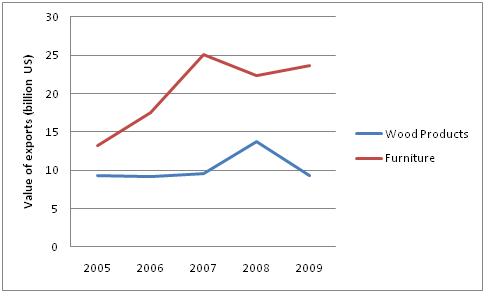The process of establishing the Central American-Dominican Republic Free Trade Agreement (CAFTA-DR) began in 2006 in El Salvador, Guatemala, Honduras and Nicaragua, Dominican Republic in 2007, and in Costa Rica in 2009. This region is the 14th largest export market for U.S. products (USEAC 2011). CAFTA-DR will phase out tariffs between the U.S. and Central American countries within 15-20 years (USDA FAS 2009). Some tariffs were immediately duty free after the trade agreement took effect (USDA FAS 2009). The trade agreements help to expand market opportunities and allow companies to compete in the global market (USEAC 2011). From 2006 to 2008, the export of wood products from the Appalachian region to Central America increased by 51% (Figure 1). Furniture exports to Central American increased by 43% from 2006 to 2007(Figure 1). The rise in exports from the Appalachian region to Central America may be a result of the establishment of CAFTA-DR. Due to unstable financial markets, tighter credit limits, and increase freight rates global exports of Appalachian wood products and furniture decreased in recent years (Figure 1; VDACS 2008). To increase sales the Appalachian region needs to increase product competiveness by expanding export markets and improving product promotion (Wang et al. 2010).

The CAFTA-DR may help increase exports of wood products from the Appalachian region. A 1996 study on the North American Free Trade Agreement (NAFTA), Prestemon (1996) found that lumber and plywood were to gain the most from free trade out of all wood products being exported. Hardwood lumber exports were expected to increase from 45-120% as a result of NAFTA (Prestemon 1998). It is important for Appalachian forest products companies to identify Central America as a potential export market.
